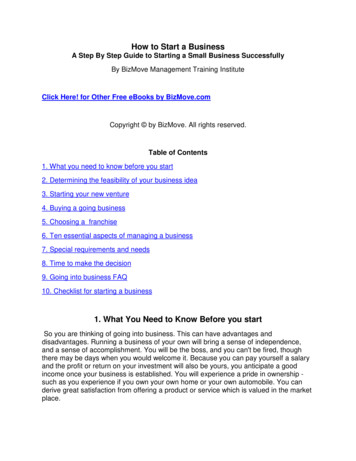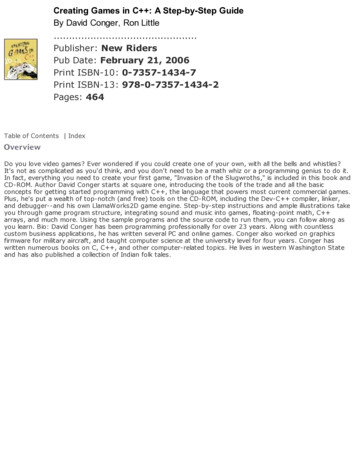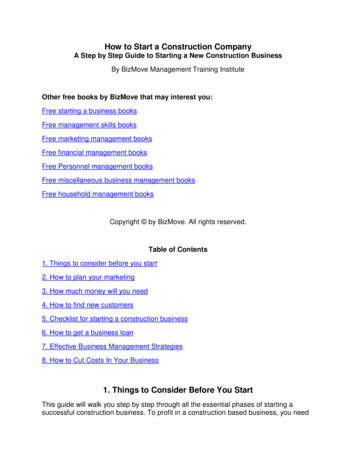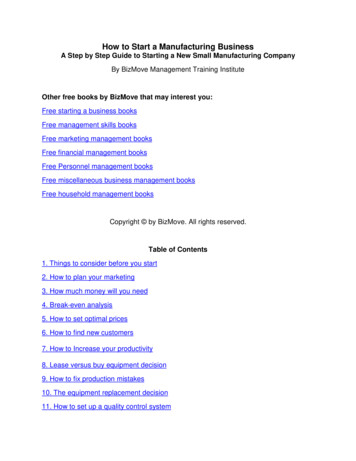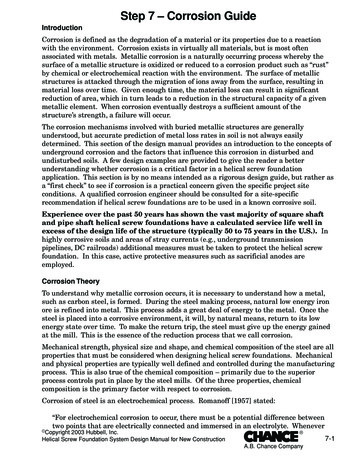
Transcription
Step 7 – Corrosion GuideIntroductionCorrosion is defined as the degradation of a material or its properties due to a reactionwith the environment. Corrosion exists in virtually all materials, but is most oftenassociated with metals. Metallic corrosion is a naturally occurring process whereby thesurface of a metallic structure is oxidized or reduced to a corrosion product such as “rust”by chemical or electrochemical reaction with the environment. The surface of metallicstructures is attacked through the migration of ions away from the surface, resulting inmaterial loss over time. Given enough time, the material loss can result in significantreduction of area, which in turn leads to a reduction in the structural capacity of a givenmetallic element. When corrosion eventually destroys a sufficient amount of thestructure’s strength, a failure will occur.The corrosion mechanisms involved with buried metallic structures are generallyunderstood, but accurate prediction of metal loss rates in soil is not always easilydetermined. This section of the design manual provides an introduction to the concepts ofunderground corrosion and the factors that influence this corrosion in disturbed andundisturbed soils. A few design examples are provided to give the reader a betterunderstanding whether corrosion is a critical factor in a helical screw foundationapplication. This section is by no means intended as a rigorous design guide, but rather asa “first check” to see if corrosion is a practical concern given the specific project siteconditions. A qualified corrosion engineer should be consulted for a site-specificrecommendation if helical screw foundations are to be used in a known corrosive soil.Experience over the past 50 years has shown the vast majority of square shaftand pipe shaft helical screw foundations have a calculated service life well inexcess of the design life of the structure (typically 50 to 75 years in the U.S.). Inhighly corrosive soils and areas of stray currents (e.g., underground transmissionpipelines, DC railroads) additional measures must be taken to protect the helical screwfoundation. In this case, active protective measures such as sacrificial anodes areemployed.Corrosion TheoryTo understand why metallic corrosion occurs, it is necessary to understand how a metal,such as carbon steel, is formed. During the steel making process, natural low energy ironore is refined into metal. This process adds a great deal of energy to the metal. Once thesteel is placed into a corrosive environment, it will, by natural means, return to its lowenergy state over time. To make the return trip, the steel must give up the energy gainedat the mill. This is the essence of the reduction process that we call corrosion.Mechanical strength, physical size and shape, and chemical composition of the steel are allproperties that must be considered when designing helical screw foundations. Mechanicaland physical properties are typically well defined and controlled during the manufacturingprocess. This is also true of the chemical composition – primarily due to the superiorprocess controls put in place by the steel mills. Of the three properties, chemicalcomposition is the primary factor with respect to corrosion.Corrosion of steel is an electrochemical process. Romanoff [1957] stated:“For electrochemical corrosion to occur, there must be a potential difference betweentwo points that are electrically connected and immersed in an electrolyte. Whenever Copyright2003 Hubbell, Inc.Helical Screw Foundation System Design Manual for New Construction 7-1A.B. Chance Company
these conditions are fulfilled, a small current flows from the anode area through theelectrolyte to the cathode area and then through the metal to complete the circuit, andthe anode area is the one that has the most negative potential, and is the area thatbecomes corroded through loss of metal ions to the electrolyte. The cathode area, towhich the current flows through the electrolyte is protected from corrosion because ofthe deposition of hydrogen or other ions that carry the current.“The electrochemical theory of corrosion is simple, i.e., corrosion occurs through theloss of metal ions at anode points or areas. However, correlation of this theory withactual or potential corrosion of metals underground is complicated and difficult becauseof the many factors that singly or in combination affect the course of the electrochemicalreaction. These factors not only determine the amount or rate at which corrosionoccurs but also the kind of corrosion.”Depending on the many factors that affect the electrochemical reaction, corrosion canaffect a metal in several different ways. Some of these types are listed below:Table 7.1 - Corrosion TypesTypeCharacteristicsUniform or near uniform Corrosion takes place at all areas of the metal at the same orsimilar rate.LocalizedSome areas of the metal corrode at different rates than otherareas due to heterogeneities in the metal or environment.This type of attack can approach pitting.PittingVery highly localized attack at specific areas, resulting insmall pits that may penetrate to perforation.Considerations need to be applied as to the types and rates of corrosion anticipated.Current theory does not permit accurate prediction of the extent of expected corrosionunless complete information is available regarding all factors. Therefore, uniformcorrosion will be the corrosion type discussed herein.Romanoff states there are several conditions that must be met before the corrosionmechanism takes place. These are:1. Electrical FactorsTwo points (or areas) on a metallic structure must differ in electrical potential (anode andcathode). The anode is defined as the electrode of an electrochemical cell at whichoxidation occurs as the negative terminal of a galvanic cell. The cathode is defined as theelectrode of an electrochemical cell at which reduction occurs: the positive terminal of agalvanic cell. An electrical potential can be caused by differences in grain orientationwithin the steel structure, i.e. difference orientations of the steel grain structure can causesome grains to act as anodes while others act as cathodes, while the rest of the steelmaterial exhibits excellent electrical conductivity. In addition, chemical anisotropy, nonmetallic inclusions, strained and unstrained areas, and other imperfections on the surfaceof a metal can create potential differences – which drives the corrosion process.2. Metallic PathThe anode and the cathode must be electrically bonded or connected to complete thecircuit. 7-2A.B. Chance Company Copyright2003 Hubbell, Inc.Helical Screw Foundation System Design Manual for New Construction
3. ElectrolyteThe principle function of soil moisture is to furnish the electrolyte for carrying current.The ions in the electrolyte may be hydrogen and hydroxyl ions from the water itself and avariety of cations and anions, which depend upon the number and amount of soluble saltsdissolved in the water. The presence of these ions determines the electrical conductivity,expressed as resistivity (measured in ohm-cm), of the electrolyte, as well as chemicalproperties such as acidity or alkalinity, and the development of chemical reactions betweenthe primary products of corrosion and the electrolyte. For example, ferrous material iscorroded by electrolytes that contain sulfates or chlorides from the soil because thecorrosion products formed at the anode and the cathode are both soluble.4. AerationAeration affects the access of oxygen and moisture to the metal. Oxygen, either fromatmospheric sources or from oxidizing salts or compounds, stimulates corrosion bycombining with metal ions to form oxides, hydroxides, or metal salts. If corrosion productsare soluble or are otherwise removed from the anodic areas, corrosion proceeds - but if theproducts accumulate, they may reduce corrosion by providing a barrier that is more noble(cathodic) than the bare metal. The aeration characteristics of a soil are dependent uponphysical characteristics such as the particle size, particle size distribution, and unitweight. In volume change soils such as clay, a reduction in moisture content results incracks that provide effective channels for the oxygen of the air to reach buried metal.Disturbed soils such as fill results in oxygen being more readily available. In someinstances, atmospheric oxygen can become trapped in isolated pockets or cells creating thepotential for localized anodic regions.Soil EnvironmentsSoil TypeSoils constitute the most complex environment known to metallic corrosion. Corrosion ofmetals in soil can vary from relatively rapid material loss to negligible effects. Obviously,some soil types are more corrosive than others. The origin of soils, along with climate,geologic location, plant and animal life, and the effects of man all influence a given soilscorrosive potential. Chemical analysis of soils is usually limited to determinations of theconstituents that are soluble in water under standardized conditions. The elements thatare usually determined are the base-forming elements, such as sodium, potassium,calcium, and magnesium; and the acid-forming elements, such as carbonate, bicarbonate,chloride, nitrate, and sulfate. The nature and amount of soluble salts, together with themoisture content of the soil, largely determine the ability of the soil to conduct an electriccurrent. Therefore, fine-grained soils such as clays and some silts are considered to have agreater corrosion potential because they typically have lower hydraulic conductivity– resulting in the accumulation of acid and base forming materials, which cannot beleached out very quickly. However, granular soils such as sands and gravels areconsidered to have a reduced corrosion potential because they typically have increasedhydraulic conductivity – resulting in the leaching of accumulated salts.Ground WaterMoisture content in soil will probably have the most profound effect when consideringcorrosion potential than any other variable. No corrosion will occur in environments thatare completely dry. The effect of moisture content on the resistivity of a clay soil is shownin Figure 7.1. When the soil is nearly dry, its resistivity is very high (i.e. no corrosionpotential). However, the resistivity decreases rapidly with increases of moisture content Copyright2003 Hubbell, Inc.Helical Screw Foundation System Design Manual for New Construction 7-3A.B. Chance Company
until the saturation point is reached, after which further additions of moisture have littleor no effect on the resistivity. Figure 7.2 shows the effect of temperature on the resistivityof a soil. As the temperature decreases down to the freezing point 32 F (0 C), theresistivity increases gradually. However, at temperatures below the freezing point, the soilresistivity increases very rapidly.Figure 7.1 - Effect of moistureon soil resistivity (Romanoff, 1957)Figure 7.2 - Effect of temperatureon earth resistance (Romanoff, 1957)Soil pHThe pH can be used as an indicator of corrosion loss potential for metals in soil. “pH” isdefined as the acidity and alkalinity of a solution that is a number on a scale from 0 to 14on which a value of 7 represents neutrality and lower numbers indicate increasing acidityand higher numbers increasing alkalinity. Each unit of change represents a ten-foldchange in acidity or alkalinity and that is the negative logarithm of the effective hydrogenion concentration or hydrogen-ion activity in gram equivalents per liter of the solution.The development of acidity in soils is a result of the natural processes of weathering underhumid conditions. Acidic soils are those that have had soluble salts, and other materialsremoved – usually by moderate to high rainfall. In general, the soils of the Midwest andEastern United States are acid to a considerable depth, whereas the soils whosedevelopment has been retarded by poor drainage or other conditions are alkaline. Mostsoils fall within a pH range that is strongly acid to mildly alkaline.Extremely acid soils (below pH 4.5) and very strongly alkaline soils (above pH 9.1) havesignificantly high corrosion loss rates when compared to other soils. Soil pH is bestmeasured in the field using a pH meter by following the methods per ASTM G 51 – 77.Soil ResistivitySoil resistivity (reciprocal of conductivity) is the one variable that has the greatestinfluence on corrosion rate. However, other factors besides resistivity, such as hydrogen 7-4A.B. Chance Company Copyright2003 Hubbell, Inc.Helical Screw Foundation System Design Manual for New Construction
ion concentration, soluble salts, total acidity are inter-related, and it is difficult to controlconditions so that there is only one variable. In general, the lower the resistivity, thehigher the corrosion rate. Metals buried in low resistivity soils will generally be anodic,whereas metals buried in adjacent high resistivity soils will generally be cathodic.As shown in Figure 7.1, moisture content has a profound effect on resistivity. Soil that iscompletely free of water has extremely high resistivity. For example, sandy soils thateasily drain water away are typically noncorrosive; clayey soils that hold water have lowresistivity and are typically corrosive. Backfill material will generally be more corrosivethan native earth because the backfill soil has a higher moisture content. In addition,backfill material typically never reconsolidates back to the same degree as native soil,allowing more penetration and retention of water.Soil resistivity is typically measured using one or both of two methods: (1) testing onsitewith the Wenner four-pin method, and/or (2) taking a soil sample to a laboratory for a soilbox resistivity test. The recommend practice is the onsite Wenner four-pin method perASTM G57-78 standard specification. The four-pin method is recommended because itmeasures the average resistivity of a large volum
Step 7 – Corrosion Guide Introduction Corrosion is defined as the degradation of a material or its properties due to a reaction with the environment. Corrosion exists in virtually all materials, but is most often associated with metals. Metallic corrosion is a naturally occurring process whereby the surface of a metallic structure is oxidized or reduced to a corrosion product such as “rust .


